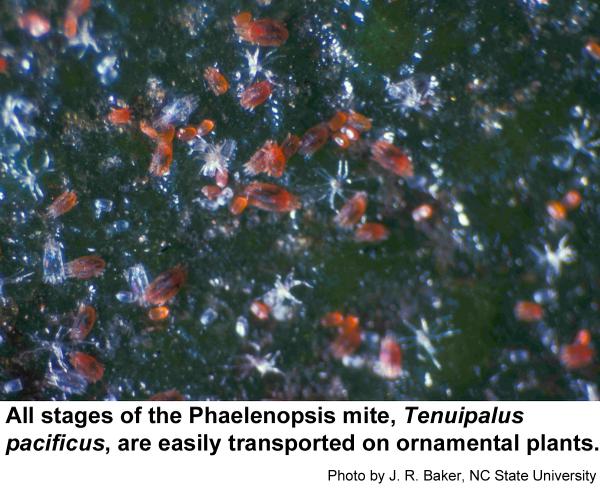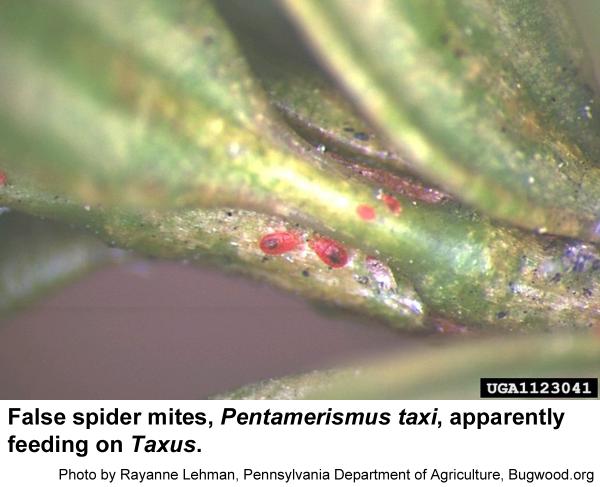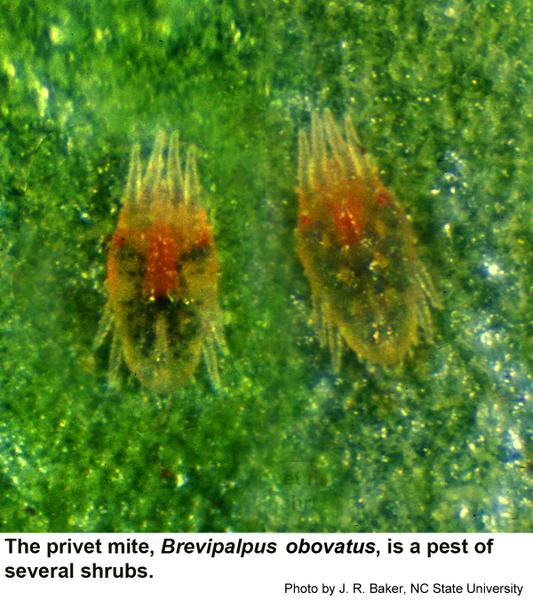General Information
False spider mites are flat and orange to red with black spots. We have several species in North Carolina. Adult mites are small (about 0.3 mm) and have eight legs. Tenuipalpus mites are broad in the middle and narrow behind. Pentamerismus mites are elongate and orange. Brevipalpus mites are strongly textured on top. False spider mite eggs are somewhat flattened, red, and sometimes ridged. False spider mite larvae are the size of the eggs and only have six legs at this stage. The protonymphs resemble adult mites in shape and have eight legs. The deutonymph, the last stage before the adult, is as large as adult false spider mites and it has eight legs (but no genital opening).
Biology
With their needle-sharp mouthparts, false spider mites puncture the epidermis of the host plant and suck out the juices. This causes a pale spot that may later turn brown. Infested shrubs slowly turn reddish-brown and appear to have "winter injury". This damage resembles that of spider mites but the onset of symptoms is much slower. Female false spider mites lay eggs that take 20 to 21 days to hatch at room temperature. Larvae hatch from the eggs and feed for about two weeks before molting into protonymphs. After 15 days of feeding, the protonymphs molt into deutonymphs. Two weeks later, the deutonymphs molt into adult mites. Incubation and development are slower outdoors in cold weather. We have four to six generations per year. By contrast, spider mites have 18 to 36 generations per year!
Host Plants
False spider mites are found throughout North America, and various species feed on a variety of ornamental, fruit, and vegetable crops. The phalaenopsis mite (Tenuipalpus pacificus) and the oncidium mite (Brevipalpus oncidii) are fairly specific to orchids. Another false spider mite, Tenuipalpus orchidarum, also feeds on orchids. The red and black mite (Brevipalpus phoenicis) has been collected on greenhouse palms, privet, citrus, and English walnut and many other plants. The omnivorous mite (Brevipalpus californicus) and the privet mite (Brevipalpus obovatus) feed on a variety of woody ornamental plants. The privet mite is common in North Carolina. Another false spider mite, Pentamerismus erythreus, has been collected on a variety of coniferous host plants: arborvitae, Chamaecyparis, Juniperus, sequoia, and spruce.
Control
Several pesticides are labled for "mite" control. Most false spider mites feed on the lower leaf surface so that the pesticide spray must be directed upwards to contact the mites. The following pesticides are suitable for home use. Use only one of the following products.
Be sure to read and follow the directions for safe application found on the label.
| Pesticide | (Trade Name) | Comments |
|---|---|---|
| fluvalinate* | (Mavrik) | |
| horticultural oil* | (Sunspray, Ultra Fine, others) | |
| soap* | (Insecticide Concentrate, M-Pede, others) | |
| abamectin | (Avid) | tends to work better in combination with horticultural oil |
| bifenthrin* | (Talstar and other formulations) | |
| disulfoton | (DiSyston) | granular (many uses discontinued) |
| pyridaben | (Sanmite) | greenhouse and nursery |
| spiromesifen | (Forbid) | 4F outdoor landscapes only |
| spiromesifen | (Judo) | greenhouse and nursery |
| * Suitable for home use. When used as directed, pyrethroids are very toxic to insects but are not particularly hazardous to humans and pets (other than fish—avoid using pyrethroids around pools, ponds, and streams). | ||
Recommendations of specific chemicals are based upon information on the manufacturer's label and performance in a limited number of trials. Because environmental conditions and methods of application by growers may vary widely, performance of the chemical will not always conform to the safety and pest control standards indicated by experimental data.
Other Resources
- Insect and Related Pests of Flowers and Foliage Plants. Baker, J. R. ed. 1994 (revised). N.C. Cooperative Extension publication AG-136.
- Mites in Floriculture. Anonymous. 2016. British Columbia Ministry of Agriculture.
- NC State Extension Plant Pathology Publications
- NC State Horticultural Science Publications
- North Carolina Agricultural Chemicals Manual
For assistance with a specific problem, contact your local Cooperative Extension center.
Publication date: May 1, 1997
Reviewed/Revised: Nov. 13, 2020
Recommendations for the use of agricultural chemicals are included in this publication as a convenience to the reader. The use of brand names and any mention or listing of commercial products or services in this publication does not imply endorsement by NC State University or N.C. A&T State University nor discrimination against similar products or services not mentioned. Individuals who use agricultural chemicals are responsible for ensuring that the intended use complies with current regulations and conforms to the product label. Be sure to obtain current information about usage regulations and examine a current product label before applying any chemical. For assistance, contact your local N.C. Cooperative Extension county center.
N.C. Cooperative Extension prohibits discrimination and harassment regardless of age, color, disability, family and marital status, gender identity, national origin, political beliefs, race, religion, sex (including pregnancy), sexual orientation and veteran status.



